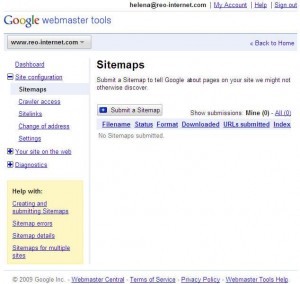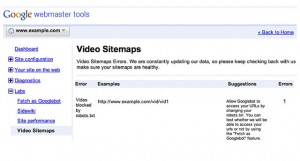Sitemaps for Search Engines
A traditional sitemap is a rather simple and efficient way for a Web site visitor to find a specific page or section on a complex Web site. It’s best to start with a home-page link then offer a list of links to main sections of the site. Those sections can offer details to pages. Be absolutely sure the links are accurate and take the visitor to the exact location described.
I n addition, it’s generally best to provide one page (sitemap) where search engines can find access to all pages. A search engine sitemap is a tool that the Web designer or administrator uses to direct search-engine spiders based on frequency and order within the Web site.
n addition, it’s generally best to provide one page (sitemap) where search engines can find access to all pages. A search engine sitemap is a tool that the Web designer or administrator uses to direct search-engine spiders based on frequency and order within the Web site.
So, when we see the term “sitemap” we are fairly sure we know what we are dealing with. The term is very descriptive of the job that this online tool is designed to do. But what about sitemaps for search engines? How do they work? In what specific ways can sitemaps help both developers and users?
Ready-Made Sitemaps for Search Engines
Several companies offer online tools that will “spider” the Web site and create a search-engine sitemap. Some of these services will work with hundreds of pages without charge. If you require the spider to work with more than 500 pages you will have to pay a basic fee. Most of these tools come with instructions on how to apply the sitemap to your site. Once the sitemap is in place you will need to submit it to search engines that will “spider” it.
This gets us to the point at which we have established a multiple-sitemap strategy. Our first, traditional sitemap is created so that visitors to your Web site have a good resource for finding their way to your content. The traditional sitemap comes with an added benefit: keyword weight to the linked pages.
Our strategy doesn’t stop there, however. The search engine sitemap lets the most-used search engines know which pages should be part of their databases. Organization and frequency are the keywords here!
Video Sitemap
We know the standard sitemap will help visitors find their way to the quality content on your site and the search engine sitemap is the key to an efficient and successful sitemap. But you may want to consider additional assistance for visitors that uses video?
When your well-designed site includes links to video players, links to other video content associated with your site and, of course, video on your own pages, you need to make sure that the major search engines (and visitors) can find what they want and need. A search engine bot will only find your video if you include all the necessary information: title and description; URL for the page on which the video will play; URL for a sample or thumbnail; other video locations, such as raw video, source video etc.
You shouldn’t be too concerned about how much space you’re taking up with video sitemaps because many tools and programs that help you establish video sitemaps will handle thousands of videos. Keep in mind that there will be limits such as a compressed limit expressed in megabytes.
We’ll use Google as an example of formats that will work for video crawling: mpg, .mpeg, .mp4, .m4v, .mov, .wmv, .asf, .avi, .ra, .ram, .rm, .flv, .swf. All files must be accessible through HTTP.
Mobile Sitemap
No, the sitemap doesn’t move! This Web site guide includes a tag and namespace language specific to its purpose. The core of the mobile sitemap is standard protocol but if you create yours with a dedicated tool make sure you can create mobile sitemaps.
This guide uses only URL language that focuses on mobile Web content. When the search engine crawls here it will not pay attention to non-mobile content. In a multiple-sitemap strategy you will need to create a sitemap for non-mobile locations. Make sure you include the <mobile:mobile/> tag!!
See a sample of a mobile sitemap for Google at:
http://www.google.com/mobilesitemap.xml or check other search engines to see what you need to do to make this work as it should. Submit mobile sitemaps as you would others.
Geography and Sitemaps
As with other targeted sitemaps, the subject of targeting certain countries with your sites can consume much more time and space than we have here. But here are some of the basics to get us started.
You can target specific countries when you set up your plan with services such as Google Web Tools. This is accomplished when you submit an XML sitemap. The bottom line is that you can submit multiple sitemaps on one domain.
User experience shows that Web site rankings increase by 25 percent or more for organic traffic. With careful SEO effort on each of the language versions the results could be even more impressive.
Submit and Grow
 To wrap up this very brief look at the subject of sitemaps, let’s consider a few of the top places for submitting your sitemaps. Keep in mind that search-engine technology has changed and improved so you will need to be familiar with the standards and requirements to be successful.
To wrap up this very brief look at the subject of sitemaps, let’s consider a few of the top places for submitting your sitemaps. Keep in mind that search-engine technology has changed and improved so you will need to be familiar with the standards and requirements to be successful.
Don’t limit yourself to the idea of submitting one URL and having the crawler do the work. This isn’t the most efficient way to get where you want to go. Devote some time to learning about submitting to Google, Bing, Ask.com, Moreover, Yahoo Site Explorer and Live Webmaster Center among others. These seem to be the top destinations in the opinion of most industry observers.
The process of submitting a sitemap differs slightly from one place to another but in general terms you use the “configuration” link and choose “sitemaps.” You’ll need to enter your complete path description in the space provided. Google’s example might look like this- http://www.example.com/sitemap.xml, type sitemap.xml) and choose “Submit.”
You should get confirmation and even a screen shot to show what you have accomplished.
Good luck!








